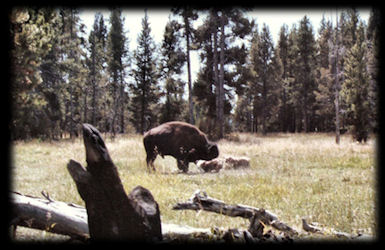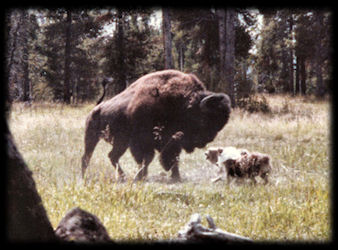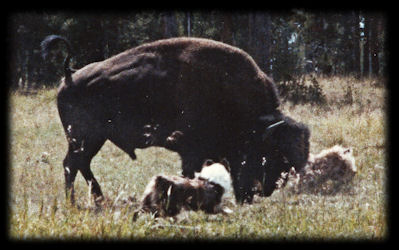|
|
||
|
Education: Books, Videos & Herding Clinics
|
The History of Las Rocosa Aussies
Chapter V: Working Wild Bison With Stockdogs
Park rangers had been trying to find an effective method of discouraging bison bulls from “setting up camp” near tourists to minimize potential problems. Reluctantly, rangers resorted to using thumper guns loaded with vials of water which produces a harmless sting to encourage the bison to move along. The effectiveness is minimal. The bulls might run fifty feet, maybe fifty yards before dropping their heads to continue grazing at their leisure.
When a ton of bison wants to go from one place to another, he isn’t detoured by conventional fences. “A bison is a lot like the proverbial 500-pound gorilla — he eats anywhere he wants to,” says bison expert, Chris Madson. A full grown buffalo bull is a powerful animal measuring five to six feet at the shoulder and nine to nine and a half feet long, weighing anywhere from 1,600 to 2,600 pounds. The cows are considerably smaller, weighing from 700 to 1,000 pounds.
The American bison is not a true buffalo, but belongs to the same family, Bovidae. His horns fit over a bony core on his massive head and are never shed. The distinctive hump is a bony structure, formed by elongated dorsal vertebrae. It extends over the shoulders just behind the back of the neck, and tapers gradually back to the hips.
Many other options had been considered for the program including using horses to haze the bison with. The shaggy monarch of the plains is deceptively fast and agile. He can outrun any horse during the first fifty yards. The bison can pump in large quantities of air, because his windpipe is four times larger than that of similar sized animals. Horses can’t compare when it comes to overall endurance. Even calves have astonishing strength and endurance.
The next phase of the program was put into the works, using stock dogs. In 1987, we were asked to assist the Department of Interior in a bison control and management project. We went on location for actual field work with our Australian Shepherds and wild bison.
It sounded like an interesting project, but one that warranted some research. After all, these animals weren’t raised in somebody’s backyard. They weren’t accustomed to being handled, let alone herded by domestic dogs that resembled predators. These were not domestic bison trained to follow “cake wagons” (vehicles dispensing cubes or pellets of processed food with molasses). Young calves can be tamed, but soon they develop the wild unmanageable traits of the adults. While bison have strong herd instincts, you can’t handle them the same as you do cattle. Bison are difficult to read because they are unpredictable. They have been known to jump fences as high as six feet. When bison get nervous and agitated they can become dangerous.
When a buffalo gets mad, he stays mad for a long time, and they can stomp the living devil out of anything. As a whole, a herd of bison is mellow. When the calves are born, bison cows become extremely protective, not unlike domestic cattle. While the cow will be the first to get you, it is the lone bull, especially if he’s been whipped out of the herd, that is the most cantankerous.
I contacted various bison experts including Jerry Olson who raised and trained bison on his ranch in the Dakotas. The bison expert on the project thought the dogs would be killed. And I must admit the thought crossed my mind. After deliberating the pros and cons with my family we concluded this would be the supreme test for our dogs. I carefully chose each individual dog. Only the most experienced cattle dogs in the fittest condition would survive. Along with miles on rough stock, each individual had to have “heart” when the going got tough. We loaded up one rainy morning and headed for the unknown. After driving for many hours into the night, we finally reached our destination. Any apprehension had vanished and was replaced by exhaustion.
Our first working location was out in an open meadow. A lone bull stood grazing peaceably and hardly took notice of the crew of park rangers, a cameraman, and other officials, including an armed marksman in the event someone’s life became endangered by a charging bison.
To begin with, I chose "Leo", CH Las Rocosa Leo Four-A ATDc STDs, because of his deliberate approach as my anchor dog. He was powerful, but wouldn’t take any foolish chance. I felt that after I saw him in action I would be able to assess the odds and figure a game plan. As Leo approached the fight/flight zone, the bull lifted his head and charged. Leo dodged him and slipped around to heel him from behind, but bison bulls don’t turn in the same manner a domestic bull does with his powerful hind legs.
When a bison spins, he pivots on his forelegs which free his assaulting hindquarters to kick out with simultaneous jabs, while he meets his challenger with his substantial head and horns. Leo avoided the attacks of the bull, and would turn and reposition himself to counter his moves. He pressured the bull and then gave him an opportunity for retreat. The bull would back a step or two and then stand, waiting like a concrete statue.
I used Rogue, a gutsy, driving dog to back Leo, also a strong driving dog. The combination was perfect and they had worked well together many times before as a team. Each lent the other support, without getting in each other’s way. Naturally the bison was not going to allow the dogs to get behind him. At one point, after backing a few steps, the bull dropped his head, waiting for an opportunity to start grazing. I asked them to “get 'em up.” Rogue moved in and grabbed the hair between the bison’s eyes, and jerked it. Silver strings of saliva blew across the air. The bull dropped his head and bulldozed his way out of the meadow and through the woods past us, shaking the earth with the dogs in relentless pursuit.
It could easily take forty to fifty minutes to move a single bull 500 yards in one direction. I felt extremely confident seeing the dogs in action. Some of the locations were actual campsites with tents and trailers, which involved carefully reading the situation to prevent things from getting out of hand. Each new situation provided new information. Some areas were open with natural obstacles. At times it appeared as though the bison were trying to work the dogs towards a fallen log to catch them disadvantaged “against the wall” so to speak.
The inevitable did happen. The afternoon was warm. The dogs had already worked several bulls when Rogue was caught beneath the piston strokes of an enraged bull’s hoofs. As he was able to pull himself free, his left hind leg was limp, dragging behind. With true Aussie character, he spun around ready to stand his ground. He wasn’t going to give up until I called him. His teammate, Leo kept the bull’s attention allowing Rogue to get out of the line of fire. He had been gored.
There were neither veterinarians nor vet hospitals for at least 80 miles. The rangers rushed us to the nearest medical facility. We laid him on the table, I told him to stay, while I steadied his head. The horns had torn deep into the flesh of his muscles, but luckily no vital organs were hit. We irrigated the wound, so the doctor could suture him up. Even without the benefit of any painkiller, never once did Rogue question or lose his trust in me. With some major stitches, he survived to work again.
Herding lone, wild bison bulls is extremely difficult, like trying to stop a freight train. While stockdogs did not prove to be a long-term solution to the bison problem, I feel that my dogs met the supreme test with success. Handling wild bison bulls is something to approach with a healthy respect. After all, they are the kings of the plains — the ultimate challenge.
© 2009 Jeanne Joy Hartnagle-Taylor
|
|




 My entourage of dogs
would not have been complete without Just Jake, a courageous little fetching
dog. Jake’s working career debut was on the range at nine months of age
when he drove 1,500 head of sheep out of the mountains of Utah into the
mountains of Colorado. I knew he had what it took to go the distance.
Now I’d see how well he could handle a freight train. His style proved
extremely effective. He never penetrated beyond a certain fine line, but
kept constant pressure driving towards the bull. Every now and then he’d
growl and let out a throaty bark. Before long, several more bulls had
wandered in. I teamed Jake up with Hondo, a friend’s gritty blue
Australian Shepherd, who was assisting me with my dogs on the project.
Together, they rounded up those bulls and put them on the move across the open
space with the ground thundering beneath their feet.
My entourage of dogs
would not have been complete without Just Jake, a courageous little fetching
dog. Jake’s working career debut was on the range at nine months of age
when he drove 1,500 head of sheep out of the mountains of Utah into the
mountains of Colorado. I knew he had what it took to go the distance.
Now I’d see how well he could handle a freight train. His style proved
extremely effective. He never penetrated beyond a certain fine line, but
kept constant pressure driving towards the bull. Every now and then he’d
growl and let out a throaty bark. Before long, several more bulls had
wandered in. I teamed Jake up with Hondo, a friend’s gritty blue
Australian Shepherd, who was assisting me with my dogs on the project.
Together, they rounded up those bulls and put them on the move across the open
space with the ground thundering beneath their feet.